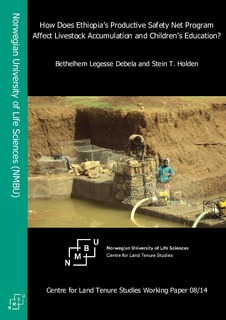| dc.contributor.author | Debela, Bethelhem Legesse | |
| dc.contributor.author | Holden, Stein Terje | |
| dc.coverage.spatial | Ethiopia | nb_NO |
| dc.date.accessioned | 2018-01-24T13:09:52Z | |
| dc.date.available | 2018-01-24T13:09:52Z | |
| dc.date.issued | 2014 | |
| dc.identifier.uri | http://hdl.handle.net/11250/2479436 | |
| dc.description.abstract | We use panel data from Northern Ethiopia to investigate the welfare impact of Ethiopia’s Productive Safety Net Program. We assess whether the program raised livestock asset levels and children’s education among participant households. Using treatment effects models, we find that participants in the public work component invested more in livestock and children’s education than non-participant households after controlling for selection into the program. Participation in the program helps to protect beneficiaries from sacrificing their children’s education in response to shocks. Our conclusion remains the same when we control for the extent of down sale of livestock to avoid graduation from the program. | nb_NO |
| dc.language.iso | eng | nb_NO |
| dc.publisher | Norwegian University of Life Sciences, Ås | nb_NO |
| dc.relation.ispartofseries | CLTS Working paper;2014:8 | |
| dc.rights | Attribution-NonCommercial-NoDerivatives 4.0 Internasjonal | * |
| dc.rights.uri | http://creativecommons.org/licenses/by-nc-nd/4.0/deed.no | * |
| dc.title | How does Ethiopia’s productive safety net program affect livestock accumulation and children’s education? | nb_NO |
| dc.type | Working paper | nb_NO |
| dc.subject.keyword | Social protection | |
| dc.subject.keyword | Assets | |
| dc.subject.keyword | Education | |

